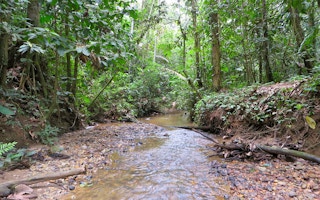During the pandemic, as researchers looked to wet markets and the animal trade in search of the source of Covid-19, there was a renewed concern for how the natural world might be impacting public health. An increasing number of experts and government officials pointed to agriculture, urbanisation and other forms of land use change as raising the likelihood that new diseases might jump from animals to humans.
But the impact that nature has on public health goes much deeper than just infectious disease. A new report from WWF attempts to broaden the narrative, laying out the different ways that forest ecosystems can play a role, both positively and negatively, on things like mental health, malnutrition and cancer.
“Forests are a public health solution,” Annika Terrana, WWF forests director and report co-author, told Mongabay, “and they should be part of our public health approach and understanding.”
While deforestation has been shown to break up forest habitats, leading to greater concentrations of contagious diseases like Covid-19, the report says, deforestation is also connected to non-infectious illness like diabetes, typhoid and respiratory disease.
Forests help filter millions of tons of pollutants from the air every year, helping reduce hundreds of thousands of incidences of acute respiratory problems like asthma. Over the long term, pollution reduction also cuts down on cardiovascular diseases, pulmonary diseases and lung cancer, among other things.
On the other hand, when forests burn, they send massive amounts of pollution into the air that can have adverse effects on human health.
Forests also help cut down on soil erosion and sediments that contribute to the pollution of drinking water, which could otherwise result in paratyphoid fever and lower respiratory tract infections, especially in rural areas, the report says.
From a public health perspective, that’s no small impact by any means. Non-communicable illnesses ranging from gastrointestinal disease to stroke to cardiovascular disease account for around 70 per cent of deaths worldwide, according to the Lancet Commission on pollution and health. In 2015 alone, pollution was linked to 9 million deaths.
“If you look at the way that forests can mitigate air pollution or mitigate water pollution, you have pretty direct correlations that forests have on clean air and water, and then the resulting impact that has on preventing non-communicable disease,” said Craig Beatty, report co-author and WWF forest strategy and research manager.
Globally, around 10 million hectares (2.5 million acres) of forest were lost every year between 2015 and 2020, according to the Food and Agriculture Organization of the United Nations (FAO). The Amazon, a critical tool for absorbing carbon, has lost 17 per cent of its area in the last 50 years.
That has a direct impact on the health and well-being of the 1.6 billion people who depend directly on forests for their livelihoods, the report says. Forest ecosystems can provide fuel and medicine to local communities as well as healthier foods than what is usually available in unforested urban areas, such as nuts, seeds, fruits and leafy greens, fish and insects.
“Children who experience malnutrition in the first 1,000 days of life go on to have compounding health problems for the rest of their lives,” Beatty said. “Forests provide a source of vitamins and nutrients that might not otherwise be available, especially in places where markets are not strong.”
People who can safely rely on forests tend to have lower pulses and blood pressure, the report says. They tend to live a more active life, which may also contribute to better mental health.
In addition to providing food, medicine and raw materials, forests’ ability to filter and store water helps lower the chance of deadly droughts, heat waves and fires, while preventing erosion that can lead to mudslides, the report points out.
A new mindset
Recognizing that forests have a direct impact on human health, WWF’s report calls for greater collaboration between conservationists and the public health sector.
“If through interacting with public health organizations we’re even able to make a 1 per cent dent in the instance of non-communicable disease through forests,” Beatty said, “that’s a massive number of people who live healthier lives with their loved ones.”
The report recommends that more be done to conserve the world’s existing forests while preventing future land use change, especially in areas where people rely on the ecosystems for their livelihoods. It calls for bolstering programs that support sustainable agriculture and says government regulations can help mitigate everything from forest fires to hazardous wildlife markets.
“Studying the thresholds and tipping points at which forests are unable to recover from various threats should be a priority,” it says. “These indicate irreversible ecological processes that land managers ought to avoid and the associated social and economic impacts with strong implications for human health.”
The report also calls for the creation of urban forests, the idea being that it would bring the benefits of the forest to people normally unable to access them. The trees would help cool cities and slow floods while filtering high-density air pollution that causes disease.
Finally, it urges people to protect forests for the sake of their own individual health, whether that means supporting conservation legislation or being responsible consumers of products that haven’t contributed to deforestation.
“Everyone is an advocate for their own health,” Beatty said. “And what we hope is that, through this report, people can advocate through their own healthcare for the role that forests can play in their and their communities’ health.”
This story was published with permission from Mongabay.com.

















